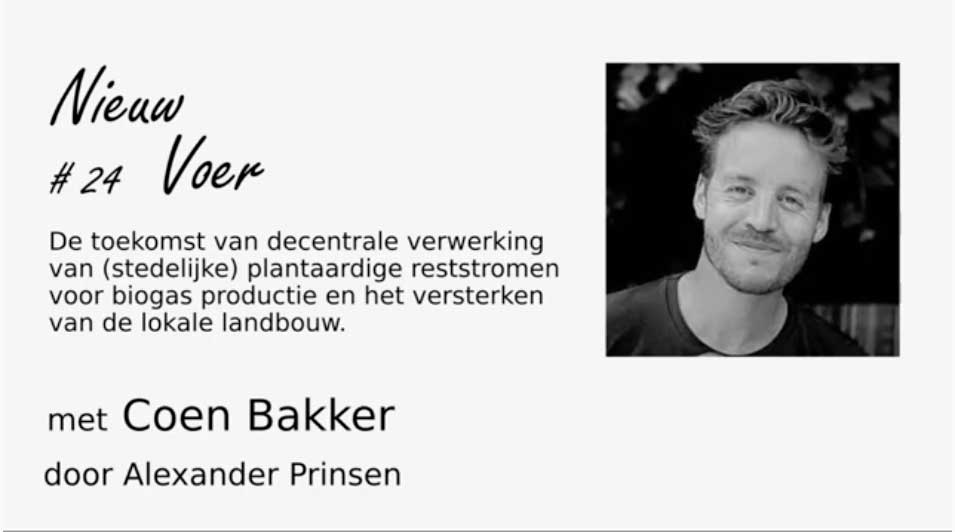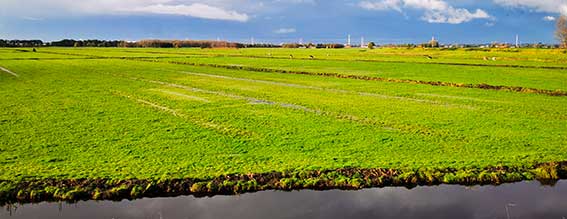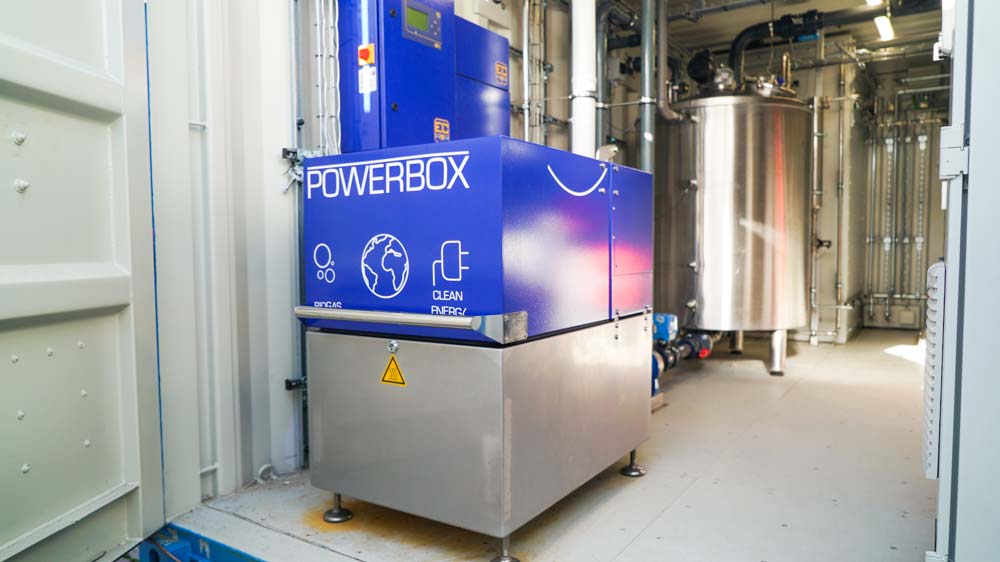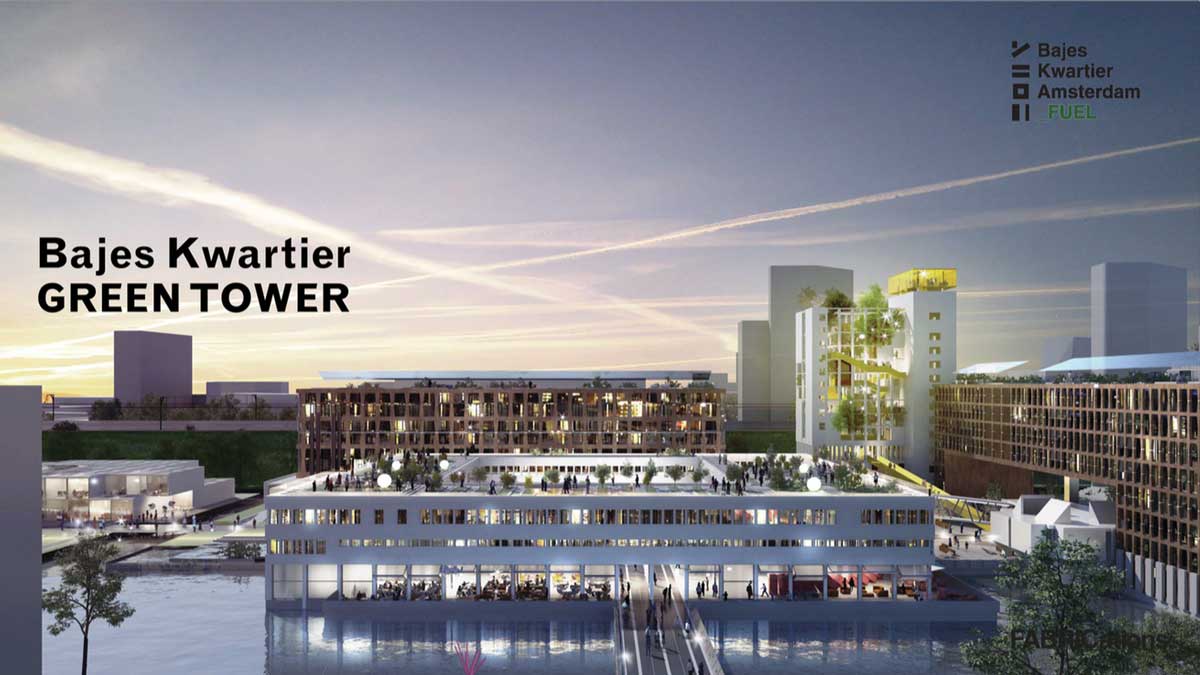This month our Marketing Manager Coen Bakker was invited to the Dutch podcast Nieuw Voer to discuss the world of food waste, how we should take care of food waste and why the food waste problem needs to be addressed similar to our global plastic waste problem.
This is a Dutch spoken podcast for all people interested in sustainable topics, for people working in an industry where they work with food, such as hotels, supermarkets, events, hospitals, airports and communities.
Listen back the podcast here:

Listen back on Spotify
Wasting food has very harmful side effects and when not treated properly it strongly contributes to global warming. If food waste were a country, it would be the third-largest contributor to greenhouse gas emissions after China and the US. The Waste Transformers have found a way to make the most optimal and hyper-local use of wasted food. They have implemented a natural process, called anaerobic digestion, inside a shipping container to process food waste on the site where it is produced. There it is turned into biogas, which is turned into electricity and heat for that same site producing the waste. The valuable nutrients taken from the soil during harvest or animal production are given back to the soil as a natural fertilizer. That is a circular and social economy around food waste.

Podcast on food waste
The podcast is broadcasted in Dutch, for our non-Dutch speakers we have summarized the podcast conversation between Alexander and Coen below:
We often mistakenly think that the citizen is the biggest cause of food waste. No less than 33 percent of the total food production is lost somewhere: during production, transport, in the supermarket, catering industry or at home. That is equivalent to the amount of food needed to feed the entire world population.
What a shame if food waste that is packed with nutrients is incinerated. Or ends up in a garbage dump where it rots uncontrollably, resulting in the release of ‘undesirable’ methane? The Waste Transformers have developed a biodigester to solve food waste ‘end of pipe’, in places where it ends up in a heap, for example at hotels, universities, event locations and food markets. By producing methane (biogas) from non-preventable food waste, electricity and heat can be produced, the CO2 in the biogas can be captured and used for new applications, and the residual product of the digestion process, the digestate, can be used as a natural fertiliser, replacing the well-known polluting artificial fertilizer.
This has made ultra-local valorisation of kitchen waste from restaurants, hotels and residential areas a reality and is being done in a way that ensures a new revenue model and a positive approach to climate change. Parties at home and abroad are now using the Waste Transformer to convert their food waste into raw materials, electricity and heat/cold at their own location.
For safety reasons, the digestate is pasteurized, which means it is heaten up to 70 degrees for one hour to eliminate all pathogens. What are its advantages and disadvantages? And what if we don’t pasteurize digestate, do the bacteria in the digester also benefit the soil? Can these digester bacteria act as a kind of probiotic for the soil?
And you may wonder why we consider the natural output of digesters to be different from a cow’s fertilizer? After all, cow droppings are not pasteurized before being brought onto the land, but it is still ‘processed’ by the worms and insects on and in the soil before they are absorbed by the plants. This is despite the fact that a fermenter actually works just like a cow’s stomach system. It makes me curious whether digestate can also be used in a different way? For example, what are the chances of using digestate as a food source for worms, fungi and bokashi instead of using it as a fertilizer?
Digester output: natural fertilizer
During the anaerobic digestion process, non-preventable food waste is converted into gases, called biogas. What remains is a digestate. This is a natural liquid fertilizer that contains nutrients that are easy for plants to absorb. It contains, among other things, phosphate, nitrogen, nitrate and trace elements (micronutrients). Of course, what you put in and what comes out also applies.
 The quality and composition of the food waste ensure the quality of the output. For example, a mix of different nutrients for the Waste Transformer gives a better result than a mono stream. It also appears that the protein volume (due to the nitrogen content) is important for the microbes and thus the proper functioning of the digester, as is a constant supply of biomass and the balance of dry and wet matter. Just like in our own intestines. And the advantage is that the bacteria in the digester get used to the kind of organic material they get.
The quality and composition of the food waste ensure the quality of the output. For example, a mix of different nutrients for the Waste Transformer gives a better result than a mono stream. It also appears that the protein volume (due to the nitrogen content) is important for the microbes and thus the proper functioning of the digester, as is a constant supply of biomass and the balance of dry and wet matter. Just like in our own intestines. And the advantage is that the bacteria in the digester get used to the kind of organic material they get.
What does the digestate contain when the waste stream changes? Is it also the case that if the residents of the neighbourhood switch to organic vegetables instead of conventional vegetables, the output of the digester will be of higher quality due to the higher nutrient density? What about the trace elements in that vegetable if you compare it with other cultivation methods? Is liquid fertilizer sufficient when used in an aquaponics system? Does it provide sufficient ingredients? After all, these are of great importance for the quality of the cultivated vegetables and therefore the health of the consumer.
Digestate for agriculture
Digestate is a natural fertilizer for our soils and doesn’t have the adverse effects of artificial fertilizers. It certainly has advantages as a replacement for artificial fertilizer, because the microbes in the soil with digestate are less bothered by too much nitrogen and can actively contribute to better soil.
Digester output: energy and heat
In addition to digestate, the digester also has other interesting outputs from the combustion of methane, namely electricity and heat. The food waste is converted into biogas in the digester and this is filtered out using a membrane system. The biogas is then burned in the cogeneration engine (CHP) and converted into electricity and heat. The heat can even be converted into cold. And that is very useful in hot countries where it can be used in coolers and air conditioners. What ultimately remains

Powerbox, a Combined Heat and Power engine.
behind is the liquid digestate, which is first pressed, so that a solid and liquid product is formed. The water is partly reused in the digester and partly used as grey water. After reprocessing with more nutrients, the final digestate can be used for local food production. And all digesters send their data to the head office for the status of the units and, if necessary, immediate and quick action can be taken.
After 50 years of centralizing services, there is a turning point. Nowadays, more and more matters are arranged decentralized and even locally. There will be a major shift towards self-sufficient homes and residential areas. The residential areas of the future in which food production, water purification, energy production and waste valorisation are integrated in the district. Is the next step a Waste Transformer in the kitchen the size of a dishwasher? And a closed cycle in the neighbourhood or even in your own home?
Applications: making food waste personal again in an Amsterdam residential area. The Waste Transformer has several applications and revenue models, depending on the country, circumstances and local needs. In a strongly built-up environment, the Waste Transformer can be integrated into a building. This is happening in Amsterdam, for example, where The Waste Transformers are placing a Waste Transformer in one of the remaining towers, the Green Tower, of the former Bijlmer prison. The tower will be converted into a complex with apartments, a hotel and offices with an indoor vertical park and farm. The organic waste from the neighbourhood is processed in the Waste Transformer, which is located at the bottom of the Green Tower. The output partly provides for the electricity and heat needs of the building and the digestate is returned to the district. The plan is that vertical vegetable cultivation (aquaponics) on water in the Green Tower will use the digestate from the Waste Transformer for its nutrients.
To close the cycle, it is important that food waste remains in the neighbourhood and is also processed there, without polluting transport in dirty diesel trucks. Collecting and visibly processing waste locally has a completely different effect than throwing garbage away in an underground container, which helps to dispose of the waste anonymously and almost invisibly, but also demotivates separation and recycling. Local waste processing provides more insight into the amount of food waste. Hopefully, this will reduce wastage. And that’s what The Waste Transformers are all about. To make food waste personal again, and bring awareness to the right use of food waste, similar to the current awareness around plastic waste.

Green Tower housing a Waste Transformer
Returning waste to where it came from, such as in Sierra Leone. What would that look like if we were to do that for imported raw materials? For example, the French grain that comes to the Netherlands and ends up in the sewer, while human faeces should actually go back to France. What happens if the cycle is not closed? How will the nutrient deficiency be solved?
Applications: community and employment around an African women’s hospital
Another application of the Waste Transformer is in a women’s hospital in Sierra Leone. A poor country with a large young unemployed population. Usually, in the informal circuit, food waste is collected from companies and homes to earn some extra money and taken to the landfill. Certain waste flows are sorted on-site and taken to neighbouring countries.
Since the arrival of the Waste Transformer, the food waste from hotels and houses around a women’s hospital is taken to the Waste Transformer. The energy that is generated is connected to the hospital and provides an alternative to the unreliable power grid and polluting diesel generator that serves in the event of a power failure, which happens a couple of times per day. The Waste Transformer thus helps to close the circle. Nutrients go back to their origin. To the neighbourhood around the hospital where the food waste comes from. A reintegration house is linked to the project where young mothers are given tools to help them find their way in society as unmarried young mothers. A good example of ‘food waste to value to community’.
Innovation implies that you look at things systemically. Legislation and regulations often do not yet facilitate this; it prefers to keep everything linear. At its core, linear thinking is about not taking supply chain responsibility, and therefore doing things differently requires systemic solutions to really organize things differently.
Innovation
What else can the fermentation of nutrient-rich waste be used for? We have seen that the Waste Transformer helps close local loops. Can the Waste Transformer also be used in the catering industry such as a cruiseship? This is a floating catering conglomerate and pre-eminently a producer of food waste. Due to laws and regulations, a Waste Transformer on board is not yet possible. The current situation is that the waste is cooled on board and delivered separately to the port. In the port, however, the waste is thrown into a heap, because more money can be earned with mixed waste. Placing a Waste Transformer in every port could be a solution and, even better, directly in a cruiseship. Then the ship can deliver natural fertilizer to the local farmers at the next port, which can produce the food for the ship.
What would be the effect of a system solution that facilitates the processing of local wastewater and food waste in a mini power station in the district?
If we look further at waste flows in residential areas, the wastewater is also a flow that is digester and a wastewater treatment facility. Even though it is a similar process, The Waste Transformers fermenter is not used for purifying water. Sewage sludge from water treatment is a different material and has a lower calorie value than biomass, which has not been the focus of the Waste Transformer’s technology.
Could waste processing be further individualized in the future, so that more responsibility and thus ownership of their own waste lies with the citizen? And would that lead to less waste? Perhaps a Waste Transformer in our house is an option. Or is it precisely this joint responsibility for waste in a neighbourhood that works best?
End of pipe solution
The digester invites you to look differently at food waste and waste separation. A good solution for the built environment that can prevent us from burning biomass or letting it rot uncontrollably. As an end-of-pipe solution, this digester comes into its own. It works optimally when the waste is mixed as opposed to a mono stream. And there is hope that the remaining emissions will also be repurposed so that everything can be used.
In the West, promoting social cohesion and appealing to citizens’ sense of ownership of their waste is interesting. The Waste Transformer is therefore potentially a vehicle for behavioural change. The Waste Transformer has a major impact on employment and the climate in countries where there is no well-equipped infrastructure, where waste is transported abroad and where the Waste Transformer creates new jobs. So more value is created than just the output of the digester and the reduction of waste transport.
Listen back the podcast on Spotify.
This summary is translated from the Podcast Nieuw Voer.
Do you want to follow us on social media, give us a page like on Facebook, Twitter, LinkedIn and Instagram.
Curious how our installation works? Watch our short movie here.
Become a frontrunner in your industry

Hotels

Airports

Universities

Communities

More industries
Get in contact with us to learn more about the possibilities of using an installation on your site to generate value from waste.
> Return to other news
